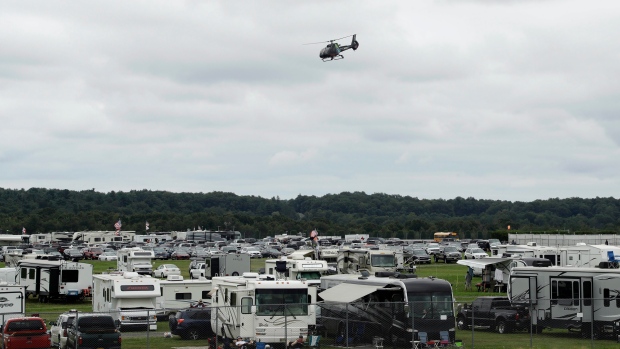Aug 20, 2018
Tracy pushing for safety changes after horrific crash
Canadian Paul Tracy is calling for change in the auto racing industry. The outspoken former IndyCar star made the comment on Instagram on Monday — the day after fellow Canadian Robert Wickens was involved in a horrific crash at Pocono Raceway — to get out his thoughts on track safety.
The Canadian Press

Alex Tagliani feels Ryan Hunter-Reay's pain.
On Sunday, Hunter-Reay was involved in a scary crash with Canadian Robert Wickens during the ABC Supply 500 at Pocono Raceway. Wickens' car sailed into the fence when he and Hunter-Reay made slight contact.
Wickens, of Guelph, Ont., had titanium rods and screws placed in his spine Tuesday to stabilize a fracture associated with a spinal cord injury suffered in the crash. Wickens remains in stable condition but is expected to require more surgeries to treat fractures in his lower extremities and right forearm.
Hunter-Reay was uninjured but tweeted Monday he's having trouble letting go of the accident.
"Praying for @robertwickens," he said. "Since the moment my car came to a stop after that horrific crash all I can think about is Robbie's well being.
"Thinking about Karli and their whole family. He's as tough as they come, I know he'll be focused on getting back on track."
Hunter-Reay ended the tweet with an emoji of praying hands.
Tagliani was involved in a horrific crash with Alex Zinardi in 2001. Zinardi lost both legs in the accident and Tagliani, of Lachenaie, Que., admitted he struggled mightily getting over the incident.
"That was a point in my career where I almost gave up," Tagliani said during a telephone interview Tuesday. "It caused me to rethink my desire to stay in racing.
"The next race was in England and it's the one race in my career that I don't even remember what happened. I don't remember where I finished, I don't remember what my pit strategy was. I felt as a driver I went there and raced and my mind was so full of a lot of things that I couldn't have a clear mind to race the way my mind was before the accident."
Tagliani said, in retrospect, he probably shouldn't have resumed racing so quickly. But he credits Zinardi's wife, Daniella — who told Tagliani the accident wasn't his fault and he shouldn't feel responsible for it — and Zinardi himself with giving the Canadian much-needed closure.
"Alex's wife came to see me at the hospital and we communicated via Twitter," Tagliani said. "She's a hell of a lady, the strength she has for family is incredible but what she did for me, for my mind, was incredible.
"When Alex came to Toronto, we gave each a big hug and started talking Italian. He made me laugh by saying the advantage he had now was he was an inch taller with his prosthetic limbs. His attitude and demeanour lifted so much weight off my shoulders."
Wickens, 29, is in his first IndyCar season after winning a championship in touring cars in Europe. He left that series this year to try IndyCar alongside childhood friend James Hinchcliffe, of Oakville, Ont.
Hinchcliffe and Wickens drive for Schmidt Peterson Motorsports, and Wickens had been surprisingly competitive since his series debut. He was poised to win the season opener at St. Petersburg, Fla., before spinning in the closing laps. Wickens stood sixth in the driver's standings before the crash.
Hinchcliffe, who also was involved in the crash at Pocono, has been medically cleared and will race Saturday at the Bommarito Automotive Group 500 in Madison, Ill., the team announced. But Wickens' No. 6 car won't have another driver Saturday.
Team owner Sam Schmidt was paralyzed when he crashed during a test at Walt Disney World Speedway in 2000. The accident left Schmidt a quadriplegic.
Toronto's Paul Tracy took to Instagram on Monday calling for change. The former IndyCar star said, "It's long overdue for the racing industry to start looking into a new way of retaining the cars inside the track without poles, fence and cable."
Tagliani agreed.
"The next step should be a huge focus on the fencing because the fencing has created many similar incidents to what happened to Robert," Tagliani said. "There's something that has to be thought out with either increasing the size of the wall, putting something like a bullet-proof material in front of these existing fences in the corner to be able to keep the cars inside the track.
"When I see something like this, the way I'm built inside and maybe I'm not built correctly, I want to see a solution. I want to see someone moving forward and taking some proactive action."
In 2011, two-time Indy 500 winner Dan Wheldon died when his car flew into a catch fence after hitting another at Las Vegas Motor Speedway. Four years later, the closed cockpit debate was re-ignited when Justin Wilson died after being struck in the head by debris from a crash at Pocono.
But Tagliani said a canopy wouldn't have helped Wickens.
"If you can't keep the car on the track you're better off focusing on making the track safer because cars are just going to keep climbing up on top of each other," Tagliani said. "You could put a canopy on Robert's car and he would've still suffered the same injuries.
"At the end of the day a fence is just like a saw. It will saw a car like there's no tomorrow and when you get a car in a fence, the damage it will do to the car and driver is huge."
---
-- With files from The Associated Press.
